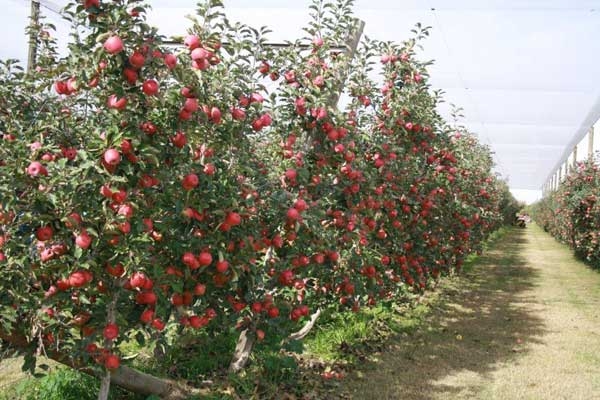The aim of maintenance pruning is to ensure that apple and pear trees have the right amount of vigour to produce an abundance of good quality fruiting wood every year. This simplistic statement really goes a lot further.
Excluding irrigation, tree pruning is the most important horticultural practice a fruitgrower can control.
Maintenance pruning deals with that critical (and seemingly elusive) balance between vegetative and fruit growth.
One fundamental fact, not always fully understood, is that about one-third of an apple tree cannot be seen.
The root system is a large underground reservoir of nutrients, carbohydrates and growth regulators. And this reservoir remains undisturbed when you prune your trees in winter.
A drastic reduction in the number of potential growing points above-ground, as a result of pruning, has the net effect of greatly increasing the supply of reserves to each of the remaining growing points.
The inevitable result of such an imbalance can be excessive shoot growth.
Shoot growth is more predictable and more manageable if a stable top to root ratio can be maintained.
Develop a stable relationship
The first requirement for such a stable relationship between top and roots is consistency in pruning from year to year.
Alternating cycles of neglect and compensatory hard pruning provide a very unstable base for the development of a program of vegetative growth control. It is for this reason that maintenance pruning really starts when the trees are planted.
Regalis® offers benefits for managing tree vigour, light distribution throughout the tree’s canopy, and fruit bud formation. But you should not regard it as a substitute for pruning your trees correctly and consistently.
The relationship between vegetative growth and fruit production is a function of balancing the top with the roots. More tree training and less pruning in the early years will set the pattern for balanced growth and consistent cropping.
When this has been achieved within the first three to five years after planting, a simple renewal pruning method can be maintained according to the 1-2-3 rule.
The purpose of this rule is to keep the bearing wood young, prevent biennial bearing, and avoid the development of a totally spurred-up situation.
Here is how you do it
First, see The 1,2,3 rule (below).
Ideally, one-third of the fruiting wood of an apple or pear tree should be one year old, one-third two years old and the other one-third three years old.
Some short stubs of older wood may be present to support the younger wood, but this should only be a small proportion of the total wood that remains after dormant pruning.
The 1-2-3 rule of pruning avoids possible fluctuations in yields and biennial bearing because there are always young spurs with buds at a safe distance where they cannot be influenced by the gibberellins produced in seeds of fruitlets.
How well you can apply the 1-2-3 rule of pruning depends on how well you have managed sunlight in your trees and provided adequate cross-pollination.
If you trained your trees well in the formative years, and kept the size of the trees at the correct height in summer (80 and 60 per cent of row width for Central Leader and Tatura respectively) and within their allotted spaces, detailed renewal pruning ensures consistent optimum production of good quality fruit.
The 1,2,3, rule
RULE 1
The first rule deals with the one-year-old pencils. These pencils are about 200 to 300 mm long and a little thinner than a pencil.
The buds at the tips are fruit buds.
Pencils without a fruit bud are also suitable provided they are short and not upright.
You must never cut these pencils. If you have too many, space-remove some—keep the ones that are mostly horizontal.
These pencils are the foundation of your fruiting wood. Make sure you have always plenty to choose from. About 33 per cent of the renewal wood on your trees should consist of these one-year-old pencils.
RULE 2
During the second year many pencils bear fruit at their tips, produce one or two bourse shoots each, and the pencils spur-up.
How you prune this two-year-old wood depends on the number of fruit buds on the tree and the vigour of the tree. You have two options:
First option: cut back to the ‘ring’. This can be the ring behind the bourse, or the ring dividing the one-year-old wood from the two-year-old wood.
This is called the ring cut or fertility cut, because it greatly enhances set of fruit on the two-year-old wood.
Second option: cut deeper than the ring to reduce the number of fruit buds.
Some apple varieties set a lot of fruit buds on their two-year-old wood, others don’t. You often find differences on the same tree and you may therefore use both options on the same tree according to the bud load.
The fruit buds on this two-year-old wood have strong flowers, which will produce the best size and quality fruit if the wood is positioned horizontally, and the fruit has space to grow and receives sunlight.
About 33 per cent of the renewal wood in your trees should consist of this two-year-old wood.
RULE 3
When the two-year-old wood has been cropped and the trees have gone dormant, this wood has become three years old.
This three-year-old wood is renewed when cut back to generate new growth which will become one year old.
Thus the cycle can start again.
For more information and images, download the August 2012 issue of Tree Fruit






















